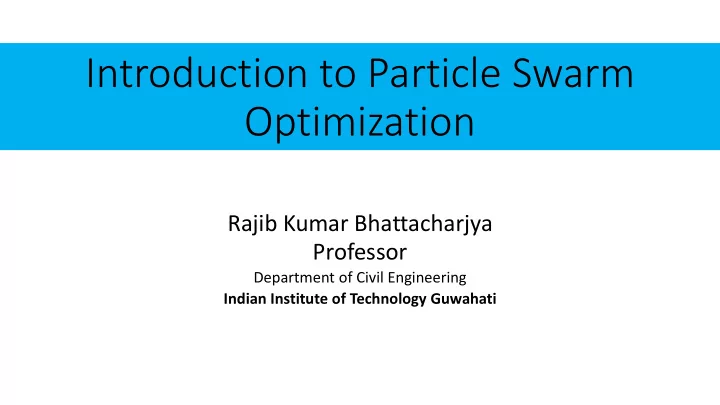

Introduction to Particle Swarm Optimization Rajib Kumar Bhattacharjya Professor Department of Civil Engineering Indian Institute of Technology Guwahati
Particle Swarm Algorithm Inspired by social behavior of bird flocking and fish schooling United we stand Suppose a group of birds is searching food in an area Only one piece of food is available Birds do not have any knowledge about the location of the food But they know how far the food is from their present location So what is the best strategy to locate the food? The best strategy is to follow the bird nearest to the food
Particle Swarm Algorithm Next position Current position A flying birds has a position and a This searching process can be artificially velocity at any time 𝑢 simulated for solving non-linear optimization problem In search of food, the bird changes his position by adjusting the velocity So this is a population based stochastic optimization technique inspired by social The changes the velocity based on his past behaviour of bird flocking or fish experience and also the feedbacks received schooling from his neighbour
Particle Swarm Algorithm Each solution is considered as bird, called particle All the particles have a fitness value. The fitness values can be calculated using objective function All the particles preserved their individual best performance They also know the best performance of their group They adjust their velocity considering their best performance and also considering the best performance of the best particle
Particle Swarm Algorithm Inertia effect Initialize particles Evaluate fitness of each particles Local search, personal influence Modify velocities based on previous best and global best positions Global search, Social influence Next iteration Terminate criteria STOP Velocity is updated 𝑊 𝑗+1 = 𝜕𝑊 𝑗 + 𝐷 1 ∗ 𝑠𝑏𝑜𝑒() ∗ 𝑄𝐶 𝑗 − 𝑌 𝑗 + 𝐷 2 ∗ 𝑠𝑏𝑜𝑒() ∗ 𝐻𝐶 𝑗 − 𝑌 𝑗 Position is updated 𝐷 1 and 𝐷 2 are the learning factor 𝑌 𝑗+1 = 𝑌 𝑗 + 𝑊 𝑗+1 𝜕 is the inertia weight
Particle Swarm Algorithm 𝑄𝐶 𝑗 Personal best performance 𝑌 𝑗 𝐻𝐶 𝑗 Best performance of the group 𝑌 𝑗+1 𝑊 𝑗
Recommend
More recommend